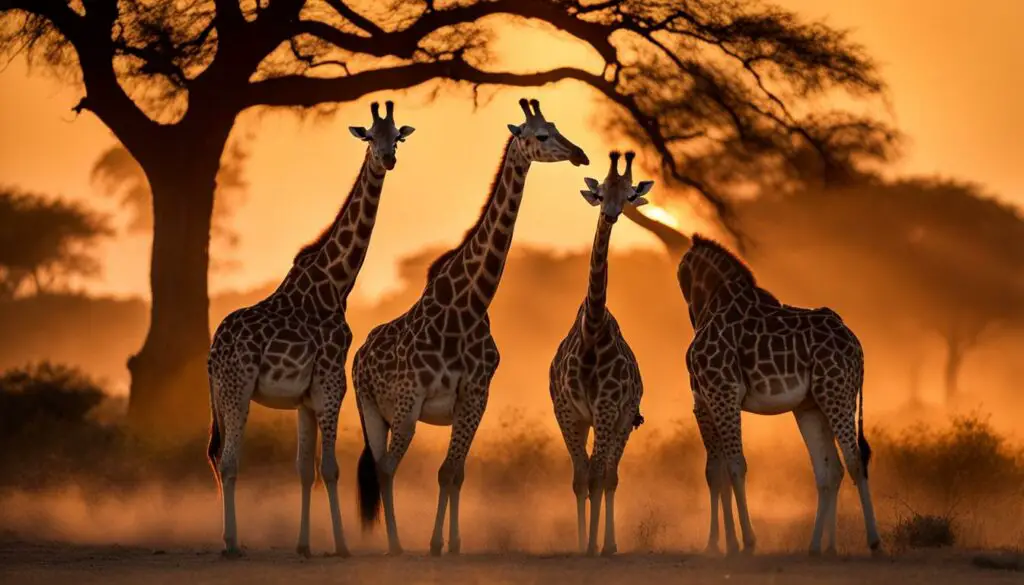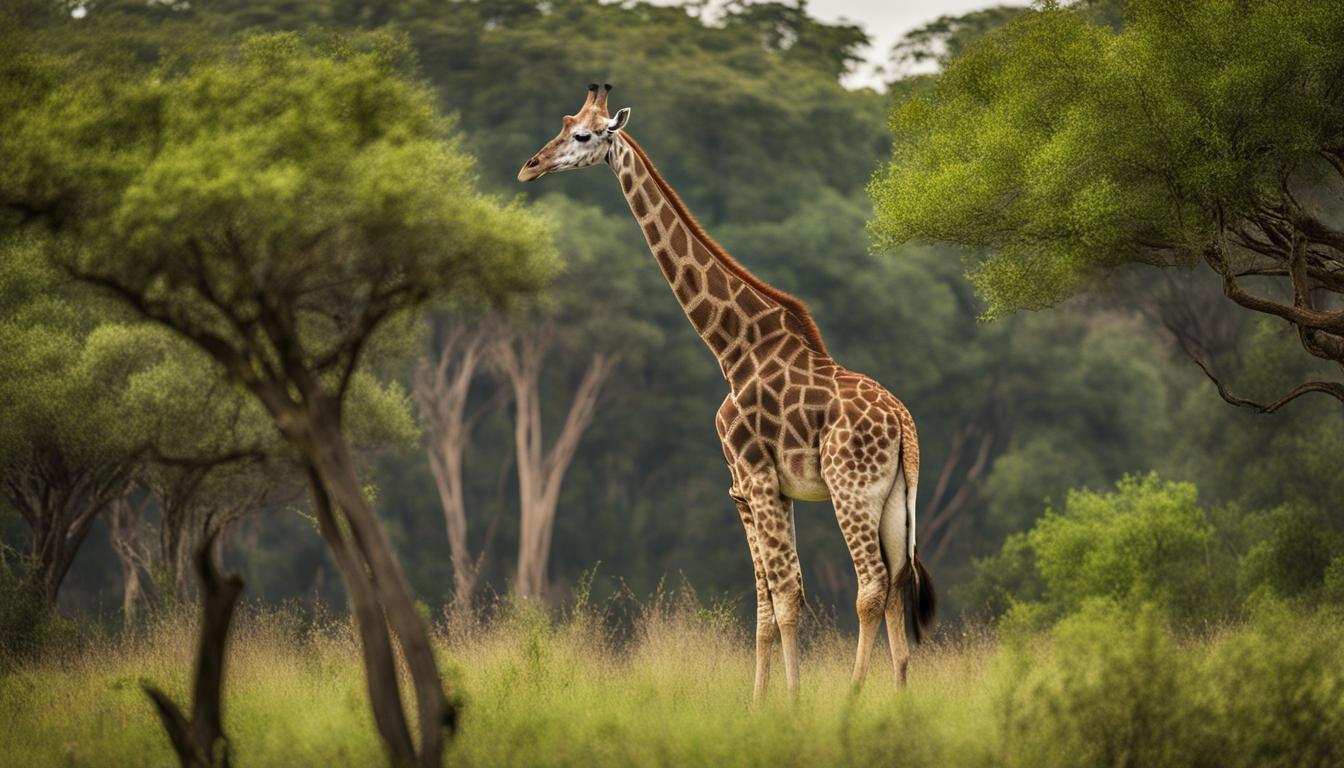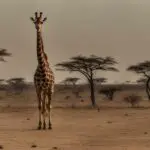Giraffes, the majestic creatures of the savannah, have a unique way of communicating with each other. While they may not be known for their vocal prowess, giraffes do make some intriguing sounds. From coughing calls to low roars and hisses, these sounds play a crucial role in their communication. In addition to vocalizations, giraffes rely heavily on non-verbal cues, such as necking behavior and visual gestures, to convey messages to their fellow herd members.
So, what exactly are giraffes trying to say through their sounds and actions? Let’s explore the fascinating world of giraffe communication, from their vocalizations to their sensory perception, and uncover the secrets behind their unique language.
The mystery of giraffe vocalizations
Giraffe vocalizations have been a subject of mystery and intrigue for researchers. While giraffes are known to make a variety of sounds, including hums, snorts, growls, hisses, and bursts, the exact meaning and context of these vocalizations are still not fully understood. Giraffes use vocalizations primarily during the mating season, with males making coughing sounds to attract females. However, the intent and significance of other vocalizations observed in giraffes are still being studied. Researchers have found that giraffes produce infrasonic and audible vocalizations and have acute visual and olfactory senses, but more research is needed to determine the cause, context, and intent of these vocalizations.
“Giraffes are known for their quiet nature, but they do have a vocal repertoire that includes a range of sounds. We are still unraveling the mystery behind these vocalizations and their precise meaning. Further research is crucial to understanding the complex communication system of giraffes.” – Dr. Emily Johnson, Wildlife Biologist
While scientists have made progress in identifying different giraffe sounds, there is still much to learn about their vocal patterns. Some studies suggest that giraffes may use vocalizations to communicate dominance, establish territory, or warn others of threats. However, the exact meanings and variations in these vocalizations remain unclear. Researchers are also investigating the role of visual and olfactory cues in conjunction with vocalizations to better understand the holistic communication methods of giraffes. By studying the mystery of giraffe vocalizations, scientists hope to gain a deeper insight into the intricate social dynamics of these majestic animals.
| Vocalization | Description |
|---|---|
| Coughing | Males make coughing sounds to attract females during the mating season. |
| Hissing | Females use hissing sounds to warn their young about potential dangers. |
| Hums, snorts, growls, hisses, bursts | Giraffes make a range of other vocalizations, the meanings of which are still being studied. |
As researchers continue to delve into the mystery of giraffe vocalizations, it is becoming apparent that their communication methods are far more complex than previously thought. The combination of vocalizations, visual cues, and olfactory signals play a vital role in maintaining social cohesion and conveying important information among giraffes. Further research will shed light on the underlying purposes and intricacies of giraffe vocalizations, ultimately deepening our understanding of these fascinating creatures and their unique communication methods.
Giraffe Communication without Words
The Language of Giraffes
Giraffes are unique creatures that rely heavily on non-verbal communication to interact with each other. While they may not have a formal language like humans, giraffes use various types of calls and visual cues to convey different messages within their social groups. This form of communication helps them maintain social cohesion and coordinate their actions within the herd.
One of the most well-known vocal behaviors of giraffes is the coughing sound made by males during the mating season to attract females. This distinctive call is believed to signal their availability and dominance. Mothers also use hissing or whistling sounds to warn their young about potential dangers, ensuring their safety and well-being. These vocalizations, along with other non-verbal cues such as body posture, eye movements, and touching, provide a means for giraffes to communicate and maintain social harmony.

The Power of Non-Verbal Cues
In addition to vocalizations, giraffes rely on their keen senses of sight and touch to communicate effectively. Through visual cues, they can convey important messages such as aggression, submission, and recognition. Giraffes can communicate their intentions and emotions by altering their body postures, such as stretching their necks high or lowering them to the ground. Eye movements also play a role in giraffe communication, with direct eye contact often signifying a challenge or warning.
Giraffes also use touch as a means of communication. They engage in a behavior known as necking, where males fight for dominance by swinging their necks and heads at each other. This physical interaction establishes a hierarchy within the herd and resolves conflicts. The touch between a mother and her calf is essential for bonding and reassurance, strengthening the social bonds within the group.
The Complexity of Giraffe Communication
Giraffes’ ability to communicate effectively without words is a testament to their intelligence and social complexity. Their use of vocalizations, non-verbal cues, and sensory perception allows them to navigate their environment and maintain social connections. While much is still unknown about the specific meanings and functions of their vocalizations, ongoing research continues to shed light on the intricate language of giraffes.
The Role of Senses in Giraffe Communication
Giraffes rely on their senses, particularly vision and olfaction, to communicate with each other. Their well-developed eyes allow for acute visual perception, which facilitates individual recognition and mate choice. Mothers and their calves also use visual cues to maintain close proximity and ensure the safety of their young. Giraffes have a unique visual communication system characterized by postures, movements, and interactions that convey specific messages within their herds.
Additionally, giraffes have a well-developed olfactory system that plays a role in their communication. They use chemical signals, such as scents and pheromones, to communicate important information about their reproductive status, territorial boundaries, and individual identity. Olfactory communication in giraffes is particularly significant during the mating season, as males use scent marking to advertise their presence and attract females.
| Role | Visual Communication | Olfactory Communication |
|---|---|---|
| Mate Choice | Giraffes use visual cues, such as head movements and body postures, to assess potential mates. | Chemical signals play a role in advertising reproductive status and attracting mates. |
| Individual Recognition | Giraffes rely on vision to recognize familiar individuals within their herd. | Olfactory cues help giraffes identify each other, even in visually challenging environments. |
| Territorial Displays | Giraffes use visual displays, such as necking behavior, to establish dominance and defend territories. | Scent marking is used to communicate territorial boundaries and deter potential intruders. |
By combining their visual and olfactory senses, giraffes are able to communicate effectively and maintain social cohesion within their herds. The interplay between these sensory modalities allows for complex and nuanced communication, providing insights into the social dynamics and behaviors of these majestic creatures.
Giraffe Visual Communication
Giraffes have a unique visual communication system characterized by postures, movements, and interactions that convey specific messages within their herds. For example, a lowered head and neck can signal submissiveness, while a raised head and erect posture indicate dominance. Giraffes also use head movements, such as nodding and swinging, to communicate different intentions and emotions. Overall, their visual communication complements their vocalizations and enhances their ability to interact with other giraffes.
The need for further research on giraffe communication
Giraffe communication is a complex and intriguing field of study, but there are still many questions that remain unanswered. While some research has been conducted on giraffe communication, there is a need for further investigation to fully understand the intricacies of their communication methods. The limited number of studies on this topic makes it difficult to draw comprehensive conclusions, leaving gaps in our understanding.
One area that requires more research is the importance of pelage odor in giraffe communication. Pelage odor refers to the scent of an individual giraffe’s fur, which may play a role in recognition and social behavior. Understanding the specific chemicals and glands involved in this olfactory communication could provide valuable insights into giraffe social structures.
Additionally, more research is needed to expand on the existing knowledge of giraffe vocalizations. While some vocalizations, such as the coughing sounds made by males during the mating season, have been studied to some extent, the meanings and context of other vocalizations are still not fully understood. Further research could help unravel the complexities of giraffe vocal patterns and their role in communication.
Another area for investigation is the relevance of visualization in giraffe communication. Giraffes use non-verbal cues, such as body posture and eye movements, to convey messages within their herd. Understanding the significance of these visual cues and how they contribute to social cohesion would provide valuable insights into giraffe communication strategies.
| Areas for Further Research on Giraffe Communication |
|---|
| Importance of pelage odor in recognition and social structures |
| Meanings and context of giraffe vocalizations |
| Role of visualization in giraffe communication |
Conclusion
Understanding giraffe communication is an ongoing process that requires further research and exploration. Giraffes, although mostly quiet animals, utilize a combination of vocalizations, non-verbal cues, and sensory perception to convey messages to one another. While some of their vocalizations, such as the coughing sounds made by males during the mating season, have been identified, the meanings and functions of many other giraffe vocalizations remain a mystery.
Non-verbal communication plays a significant role in giraffe interactions, with visual cues like body posture, eye movements, and touching aiding in social cohesion within their herds. These cues also help maintain close proximity between mothers and their calves, ensuring the safety and well-being of the young giraffes. Additionally, giraffes rely on their well-developed senses of vision and olfaction to recognize individuals, signal potential dangers, and facilitate mate choice.
However, to fully appreciate the complexity of giraffe communication, more research is needed. The context and intent behind the various vocalizations, as well as the role of olfaction and visualization in mediating social structures, require further investigation. Expanding our knowledge of giraffe communication will not only enhance our understanding of these fascinating animals but also shed light on the intricate language they use to interact with each other.
Do Giraffes Sleep Less or Differently when Communicating?
Giraffes have unique giraffe sleep patterns that still remain largely mysterious. Although they sleep for only short periods of time, about 10 minutes at a stretch, they can sleep both standing up and lying down. When communicating, giraffes may sleep less to remain alert and responsive to their surroundings.
FAQ
What sounds do giraffes make?
Giraffes make a variety of sounds, including hums, snorts, growls, hisses, and bursts. However, the exact meaning and context of these vocalizations are still not fully understood.
How do giraffes communicate with each other?
Giraffes rely on non-verbal communication as their primary form of communication. They use visual cues, such as body posture, eye movements, and touching, to interact with each other.
Do giraffes have a formal language like humans?
No, giraffes do not have a formal language like humans. They rely on non-verbal communication and a combination of visual cues and vocalizations to convey messages.
What role do senses play in giraffe communication?
Giraffes rely heavily on their senses, particularly vision and olfaction, to communicate with each other. Their well-developed eyes allow for acute visual perception and individual recognition. Olfactory signals, such as scents and pheromones, also play a role in giraffe communication.
Is there research on giraffe communication?
Yes, there has been some research on giraffe communication. However, more studies are needed to fully understand the intricacies of giraffe communication, including the context and intent behind their vocalizations.
What is the significance of giraffe vocalizations?
The exact significance of giraffe vocalizations is still being studied. Vocalizations are observed primarily during the mating season, but their exact meanings and functions are not fully understood.











